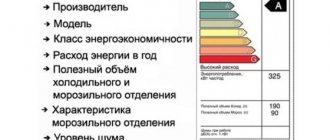TV has firmly entered into human life as a source of information, entertainment, and simply creates a background when doing household chores. At the same time, the constant increase in energy tariffs makes us think about how much electricity the TV consumes per hour and whether it is possible to save the family budget without depriving yourself of the opportunity to unlimitedly watch your favorite TV shows.
Full HD TV
How to determine how much your TV consumes
There are several ways to find out how much electricity your TV consumes. Naturally, a lot depends on which model we are talking about. As an example, consider an economical device that was purchased relatively recently.
First, take a look at the labeling. It is located on the back of the TV device. You will also find information regarding the class of electricity consumption in the instructions, which are included in the basic package.
Back in 2010, the relevant authorities of the European Union determined a single standard for the energy consumption of plasma and LED TVs:
- A+.
- A++.
- A+++.
What is the essence of the marking? The more pluses next to the letter A, the less energy the TV consumes. In 2021, a new class appeared - A++. Equipment manufacturers do not stop at the achieved results. The largest companies plan to release TVs with class A+++ by 2021.
Is it worth overpaying for equipment with an optimal energy saving class? It all depends on exactly what amount we are talking about. However, the fact remains that A++ models will use much less power than older devices.
Such marking performs not only an informational function. There are also additional benefits. For example, if there is a corresponding sticker on the TV, then the user will have more confidence in such a device. This is good advertising. Nobody wants to overpay for electricity. Therefore, users will always give preference to models with minimal electricity consumption.
Labeling is very important, but not all TVs correspond to the declared characteristics indicated on the sticker. Many devices do not have such stickers at all. But on TV screens there are other, more informative stickers. Latin letters from A to G are drawn on them.
The standard level of energy consumption is F. The sticker also contains information regarding the power of the TV. This parameter is measured in watts.
Secondly, you should always consider screen brightness. For example, the brightness of the LCD screen affects how many watts the TV uses. If the user makes the picture dimmer, then the amount of energy consumed will noticeably decrease.
How to find out power consumption
Technical data sheet
This can be useful in different situations: before purchasing in a store or at home, watching TV on a website, when calculating monthly energy consumption. There are three ways to find out how much power your TV consumes:
- Technically a passport. It should be included with any, especially large, equipment. In it, the manufacturer indicates the main indicators of the device: the power consumption of the TV, the country where production is located, the importer, technical characteristics. If it was lost or the device was purchased second-hand without it, you need to move on to other options.
- Technical information on the back of the TV. Regardless of the year of manufacture, in the same niche where the connection connectors are located or next to it there is a sticker that can partially replace a passport. The model, serial number, country of origin and technical specifications related to power supply are duplicated here.
- When searching online, just go to the technical specifications section of the store or find the website of the company that produced the TV. Many people post a catalog of their devices with all the necessary information. If the device is more than 10-15 years old, it is not sold anywhere and even the manufacturer has forgotten about it, it makes sense to look for information on the forums. If you're lucky, the model will have a base of experienced users who exchange information on setup or repair on forums. Well, or they exchanged it when the model was still on sale.
These are all ways to find out the power consumption of a TV.
What affects electricity consumption
Screen size is a key parameter that determines how much electricity a TV consumes. For example, if the screen diagonal is approximately 50 centimeters, then the device takes 0.07 kW. An incandescent lamp consumes approximately the same amount.
However, there are other factors that influence the amount of energy consumed:
- color;
- type of TV device;
- duration of active work;
- white balance;
- duration of stay in sleep mode.
Don't forget that when the TV is in sleep mode, it still uses energy. For example, devices with a 21-inch screen will consume about 16.5 watts. At first it may seem that this is not a lot, but if you multiply this figure by the number of hours, you get a very significant figure.
How to save money? Everything ingenious is simple. Simply unplug the TV device from the network. This method will save approximately 8.8 kWh.
Some users, in order to determine which TV consumes less energy, carry out the necessary calculations themselves. To do this, you need to use a special device that allows you to measure the power of the TV. It's called a wattmeter. Some device models take measurements and also save the results. Modern wattmeters automatically calculate the cost of electricity. The user preliminarily indicates the price per 1 kW.
If you do not have the opportunity to carry out the calculations yourself, then simply open the instructions for the TV. Manufacturers indicate exactly how much electricity the device consumes. The numbers are also shown during active operation and when entering sleep mode.
How much energy does a TV consume in 1 hour of continuous operation? The average power depends on the type of device: plasma, LCD, kinescope model, etc.
What is energy efficiency class
The concept of energy efficiency was introduced quite recently. It is designated by letters of the Latin alphabet from A to G. Each letter has a color designation.
As indicated in the table below.
| Class | Energy efficiency indicator % | Color corresponding to class |
| A+++ | <10 | Dark green |
| A++ | <16 | Green |
| A+ | <23 | Light green |
| A | <30 | Yellow |
| IN | <42 | Light brown |
| WITH | <60 | Brown |
The remaining classes from D to G have red color stripes of varying intensities. The power consumption of televisions of these classes is high. The industry does not produce such television receivers. The class is indicated on the packaging in the form of a colored arrow with a letter designation.
Class A+++ - low power consumption, C - high.
The energy efficiency indicator is a calculated value. It is calculated using a complex formula that takes into account numerous factors. Shows the relationship between the calculated (laboratory) value and the actual power consumption of the TV. The value is obtained as a percentage.
Types and power
The key parameters are the type of TV device and its power. Part of this has already been said earlier. It is clear that a television receiver with a cathode ray tube will consume more energy than an LCD. It is also necessary to take into account the operating time of the TV.
If you spend about 5 hours a day in front of TV, then this will ultimately add up to a significant amount at the end of the month. Modern models are equipped with useful features that allow you to save money. For example, many devices have an “Eco” mode. Activating this mode involves automatic optimization of settings. The level of illumination is taken into account. The environment is scanned by special sensors.
Recently, manufacturers are increasingly introducing such functions as presence sensors. The TV automatically turns off if no sensors detect a viewer in front of the screen.
But to a greater extent, the power consumption of a TV depends on its type. Now let’s look at different devices to demonstrate with a clear example how the amount of energy consumed changes.
CRT TVs
Let's start with cathode ray tube devices. Looking ahead, we note that models with a kinescope consume quite a lot in 1 hour. Tube TVs are characterized by a bulky screen. They are good because they are easy to maintain and have a long service life. In 60 minutes the device consumes about 60-100 W.
During the day, the TV consumes about 0.5 kW. Over a month, this figure rises to 15 kW. The device also works in standby mode. In a month it accumulates up to an additional 18 kW.
Plasma models
Plasma TV is a more modern solution. The introduction of innovative technologies into the production process allows us to create devices that reproduce images with maximum detail. The picture turns out very rich and realistic.
However, you will have to pay for a high-quality image on a plasma TV. This applies not only to the direct cost of the device, but also to paying for utilities. Let's take as an example a TV from LG with a 32-inch screen diagonal. In operating mode, about 160 W are consumed. In sleep mode approximately 0.5 W. As a result, we get an average of 25 kWh.
These figures make it clear that plasma owners will have to pay much more for light than users who prefer electronic models. What is the situation with liquid crystal devices? Let's find out now.
LCD TVs
Users are most interested in how much electricity LCD TVs consume per month. Why? Firstly, these TVs are presented in the widest range. Therefore, the user will be able to purchase a model that will fit perfectly into the room.
Secondly, there is another very interesting point. LCD TVs consume energy in proportion to the diagonal of the screen. For example, a compact device with a 32-inch screen from Samsung consumes about 50 W in 1 hour. In standby mode – 1 W. We receive only 8 kWh per month.
To save money on TV, buy a model with an LCD screen and LED backlight. The best option is a device with a diagonal of 32 inches. This technique will consume the least amount of energy.
Models with a large screen, for example, 49 inches, have impressive power - up to 150 W during active operation and about 1.5 in standby mode. We get a significant difference. In a month it accumulates about 20-22 kWh.
Modern TVs use LED backlighting. The use of LEDs significantly reduces energy consumption. As a result, the device will consume approximately 40% less. Therefore, liquid crystal models with LED backlighting are the most economical option.
What does energy consumption depend on?
The main indicator of energy consumption is the power of the TV. It is indicated in the passport or operating instructions. Measured in watts. A television receiver is one of the devices that does not operate 24 hours a day.
Therefore, the following factors influence the energy consumption of modern TVs:
- Screen size and type of television receiver - what technology is used in its manufacture. The most energy-intensive devices are old ones, with cathode ray tubes, and the minimum consumption is on a TV with an LCD screen (with the same diagonal size);
- Receiver operating time. The longer it is turned on, the more electricity it will consume;
- Balance white, black, screen brightness;
- Sleep mode and enabled features. For example, a presence sensor.
The owner can assess the power of an electrical appliance from its screen. Since the main consumer of electricity is the screen, we can say that the larger it is, the more electricity the TV consumes.
How to save
To optimize the operation of your TV as much as possible, as well as reduce the number of kilowatts, you need to follow a few simple tips:
- Install the TV device in a room with even lighting. As a result, you will be able to choose the optimal balance between brightness and contrast. Therefore, the equipment will not move much.
- Brightness must be adjusted for different types of lighting. For example, in the dark you can reduce the brightness without losing comfort during viewing.
- As mentioned earlier, TVs also consume a fair amount of electricity in sleep mode. Therefore, it is better to unplug the equipment.
- Use Eco-functions wisely. Then you can spend a minimum amount of money on paying electricity bills.
Each of these recommendations reduces energy consumption on average per day. So try to stick to them to save on your electricity bills. This is especially true during a time of ever-increasing utility rates.
So we looked at the main factors influencing the amount of TV energy consumed. Each user will be able to quickly calculate the potential costs associated with paying electricity bills.
Ways to save energy
All TVs consume electricity. And electricity bills are constantly rising. Therefore, there is a reasonable desire to find ways to save it.
Reasonable use
When watching television, you need to think carefully about the operating time of the television receiver. To ensure that the electric meter does not waste extra kilowatts, you should follow simple rules:
- Install the TV receiver in a room with uniform lighting. This will allow you to adjust the brightness and contrast to a minimum;
- Adjust the brightness while watching depending on the light in the room. For example, at night you can make the tones and brightness muted. What will have a beneficial effect on vision;
- After the transmission is complete, unplug the power supply. Do not leave the TV in standby mode;
- To avoid spending extra money, it is recommended to reduce the screen backlight;
- Buy a receiver with the smallest possible diagonal. This will save wasted energy.
Eco modes
Modern devices allow you to independently adapt to your surroundings when watching programs. This allows you to reduce energy consumption in automatic mode.
To enable eco mode, you need to enter the “settings” menu and enable the function. It is able to adjust the power of the TV depending on the program being watched and external conditions.
It is enabled during initial settings. However, this mode is not available in all models.
Presence sensor
When buying a new television receiver, pay attention to the presence of a motion sensor in the model. It turns off the TV and puts it into standby mode with minimal power consumption if the owner has left the room. When a person returns to the room, the sensor detects the movement and turns on the TV automatically. Thus, this feature will reduce energy costs.
If the owner watches a program and often leaves the room, the function will save up to 5-10% of consumed electricity.
Useful article? Rate and share with friends!
Hourly TV power consumption
Also, the average power of a TV depends on its type. If the option is with electron beam filling, then they will not be economical. This is a rather old model with a kinescope. It is known for its durability, which is why many more families still have such TVs. These devices consume 60 to 100 watts per hour, plus 2-3 watts in sleep mode. The total amount of power it produces is 15.33–19.28 kW.
The electricity consumption of LCD TVs depends on the screen size.
If you take an average screen up to 32 inches diagonally, then the power consumption will be 39–54 W per hour and 1 in sleep mode. Larger screens (49 inches) draw approximately 99–149 watts per hour. And 14.88–21.83 kilowatts come out per month.
By the way, LED devices consume 30–40% less electricity than conventional LCD TVs. This is due to the fact that the former have special diodes in the backlight, which reduce power consumption. Diodes consume electricity only in those areas of the picture that should be illuminated. In dark areas of the screen, the diodes are turned off, which saves energy.
If we talk about the electricity consumption of a TV and its cost, then:
- A Samsung LCD TV with a screen size of 32 inches diagonally consumes 0.8 kW per day and costs 218 rubles per year. It will cost approximately 18.2 rubles per month.
- A Sony KDL-55W900 TV with a kinescope costs about 40 rubles. per month for 9 kW.
- Panasonic TC-L55DT60 has a screen size of 55 inches diagonally and costs 62 rubles. per month for 14 kW.
- The Samsung PN51E450 plasma TV version costs 89 rubles. per month for 22.2 kW.
Optimizing the TV's performance
If you want to reduce your TV's power consumption in the near future, we recommend using the following rules:
- We place the TV in the most illuminated point. Thanks to this, it will be possible to adjust the brightness down.
- If we are not using the device, be sure to unplug it from the network. In this case, we eliminate energy consumption in standby mode.
- Some models have special functionality for saving money.
Relatively recently, some manufacturers began to integrate special sensors. They constantly scan the space in front of the TV; if there is no movement, the device automatically goes into sleep mode.
Also, modern models allow you to configure the screen operation quite flexibly. As a result, the amount of energy consumed can be reduced by almost half.
Plasma panels
Plasma TVs are considered by some to be the pinnacle of technology: high quality color reproduction, rich pictures. But, unfortunately, these models cannot boast of their energy efficiency. A modern panel with a diagonal of over 42 inches consumes approximately 150–190 W/hour and 0.5 W in standby mode. It is easy to calculate how much electricity such a TV will require per month - 24.36–28.86 kW. The advantage is that different images may consume different amounts of electricity, but manufacturers indicate the maximum.
Calculation of energy consumption of LCD TV per day, per month, per year
To calculate the average amount of energy that a TV consumes over a certain period of time, you can use the manufacturer’s data. Namely, the number indicated on the energy efficiency standard card. The power given by the manufacturer (consumed per month) is multiplied by a coefficient, which is defined as the ratio of the average operating time per day to four hours, as well as adjustments for the usual brightness level and the operation of the wireless adapter.
For example, the TV card indicates that it consumes 26 kW per month. However, it is installed in a bright room and set to 80% backlight. The user often uses the TV to access the Internet, and the device works on average 6 hours a day. The coefficient is determined as basic (6/4)*(80/50)*1.2 = 2.88
Calculating your monthly consumption is easy. It will be equal to 26*2.88=74.88 kW. The daily electricity consumption can be determined by division, and the annual average by multiplication. However, this figure is not considered completely reliable. For example, a user sometimes listens to his favorite TV shows on headphones or, conversely, enjoys music programs at full volume.
Advice! It is possible to determine the real indicator of how much electricity a TV consumes per hour only through practical measurements. This is done with a special device. Being an adapter between the TV power plug and the socket, it records operating currents and voltage, calculating the power consumed. They are sold both on the domestic market and on the Aliexpress global trading platform.











